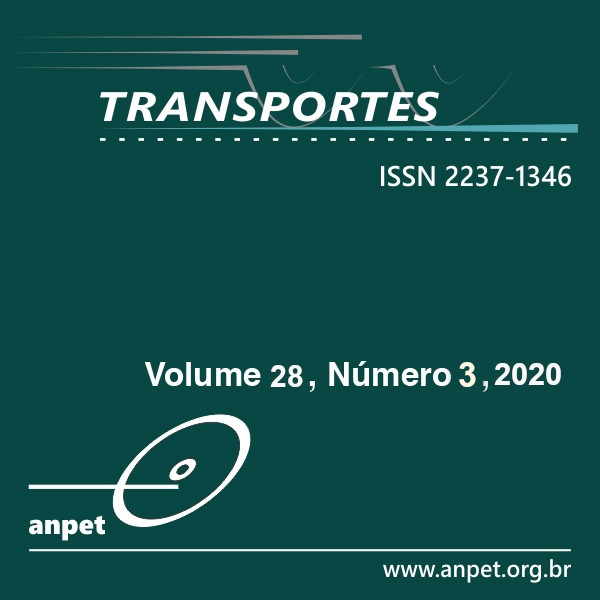Considerations about the torsion recovery test of modified binders
DOI:
https://doi.org/10.14295/transportes.v28i3.1974Keywords:
Elastic recovery test. Modified binders. Repeatability and reproducibility.Abstract
The objective of this work is to analyze Elastic Recovery Test (NLT-329/91) regarding the time of rotation of the asphalt sample and the control of the bath temperature of the asphalt during the elastic return, as well as the Repeatability and Reproducibility. Elastic Recovery Test evaluates the elastic recovery of asphalts and consists of subjecting an asphalt sample to a torsion of 180° in a range of 3 s to 5 s. The test result is expressed as percentage of elastic recovery after 30 minutes. Three types of modified binders were used. The tests were performed by two operators in spin times between 3 s and 5 s and between 30 s and 50 s, with and without water bath temperature control during the elastic return time. The results showed that torsion time influences the elastic return results. The longer the torsion time, the lower the elastic return. Variation of the water bath temperature of the asphalt during the elastic return time did not influence theresults. Repeatability and Reproducibility of the assay were high. The differences among results replicated by the same operator and among different operators were of
low variability. The total variation was 3.5% in relation to the mean and standard
deviation of 2.3.
Downloads
References
AUTOMOTIVE INDUSTRY ACTION GROUP (AIAG). Measurement systems analysis Reference Manual. 4ed. Chrysler, Ford, General Motors Supplier Quality Requirements Task Force, 2010.
Al-REFAIE, A. e N. BATA Evaluating measurement and process capabilities by GR&R with four quality measures. Measure-ment: Journal of the International Measurement Confederation, v.43, p.842-851. 2010.DOI: 10.1016/j.measurement.2010.02.016
BATES, R. e R. WORCH Styrene–Butadiene Rubber Latex Modified Asphalt. Engineering Brief No. 39. Federal Aviation Admi-nistration, Washington, DC, 1987.
CENTRO DE ESTUDIOS DE CARRETERAS DEL CEDEX. Norma NLT-329/91, Recuperación Elástica por Torsión de Betunes Asfálticos Modificados. Espanha, 1991.
CONFEDERAÇÃO NACIONAL DO TRANSPORTE – CNT. Transporte rodoviário: por que os pavimentos das rodovias do Brasil não duram? – CNT, Brasília, 2017.
DEPARTAMENTO DE ESTRADAS DE RODAGEM DO PARANÁ – DER/PR. DER/PR ES-P 28/05. Pavimentação: Concreto Asfáltico Usinado a Quente com Asfalto Borracha. Curitiba, Paraná, 2005.
DEPARTAMENTO NACIONAL DE INFRAESTRUTURA DE TRANSPORTES - DNIT. NORMA DNIT 130/2010 – ME. Determinação da recuperação elástica de materiais asfálticos pelo ductilômetro – Método de Ensaio. Rio de Janeiro, 2004.
GARCIA, A. C. e A. G. RIO Number of distinct data categories and gage repeatability and reproducibility. A double (but single) requirement. Measurement: Journal of the International Measurement Confederation, v.46, p.2514-2518, 2013. DOI: 10.1016/j.measurement.2013.04.065
MONTGOMERY, D.C. Introdução ao controle estatístico da qualidade. 4ª. ed. Rio de Janeiro: LTC, 2004.
ONOFRE, F. C.; V. T. F. CASTELO BRANCO; J. B. SOARES e A. L. FAXINA Avaliação do Efeito de Ligantes Asfálticos Modificados na Resistência à Deformação Permanente de Misturas Asfálticas Densas. Transportes, v. 21, n. 3, p. 14-21, 2013. DOI: 10.4237/transportes.v21i3.685
PEDOTT, A. H. e F. S. FOGLIATTO Estudo de repetitividade e reprodutibilidade para dados funcionais. Produção, v.23, p.548-560, 2013. DOI: 10.1590/S0103-65132012005000087
SILVA, L.S.; M. M. C. FORTE; L. P. SPECHT e J. A. CERATTI Polímeros como modificadores asfálticos. Transportes, v. 10, n. 1, p. 84-106, 2002. https://doi.org/10.14295/transportes.v10i1.164
SPIEGEL, M. R. Probabilidade e Estatística. McGraw-Hill, São Paulo, 1978.
YILDIRIM, Y. Polymer Modified Asphalt Binders. Construction and Building Materials, v. 21, n. 1, p. 66-72, 2007. DOI: 10.1016/j.conbuildmat.2005.07.007
WESTERN ELECTRIC COMPANY. Statistical Quality Control Handbook. Easton, Pa.; Mack Printing Company, 1956.
WONNACOTT, T.H. e J. R. WONNACOTT Introductory Statistics. New York. John Wiley & Sons, 1990.
Downloads
Published
How to Cite
Issue
Section
License
Authors who submit papers for publication by TRANSPORTES agree to the following terms:
- The authors retain the copyright and grant Transportes the right of first publication of the manuscript, without any financial charge, and waive any other remuneration for its publication by ANPET.
- Upon publication by Transportes, the manuscript is automatically licensed under the Creative Commons License CC BY 4.0 license. This license permits the work to be shared with proper attribution to the authors and its original publication in this journal.
- Authors are authorized to enter into additional separate contracts for the non-exclusive distribution of the version of the manuscript published in this journal (e.g., publishing in an institutional repository or as a book chapter), with recognition of the initial publication in this journal, provided that such a contract does not imply an endorsement of the content of the manuscript or the new medium by ANPET.
- Authors are permitted and encouraged to publish and distribute their work online (e.g., in institutional repositories or on their personal websites) after the editorial process is complete. As Transportes provides open access to all published issues, authors are encouraged to use links to the DOI of their article in these cases.
- Authors confirm they have obtained all required employer permissions for the publication and CC BY 4.0 licensing of the manuscript, particularly if the employer holds any claim to the manuscript's copyright. Authors assume all responsibility for employer-related copyright issues, releasing ANPET and Transportes from any related liability.
- Authors assume full responsibility for the content of the manuscript, including the necessary and appropriate authorizations for the disclosure of collected data and obtained results, releasing ANPET and Transportes from any responsibility in this regard.
Last update: 11/27/2025











